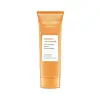What's inside
What's inside
 Key Ingredients
Key Ingredients

 Benefits
Benefits

 Concerns
Concerns

 Ingredients Side-by-side
Ingredients Side-by-side

Water
Skin ConditioningGlycerin
HumectantMyristic Acid
CleansingButylene Glycol
HumectantPotassium Hydroxide
BufferingStearic Acid
CleansingPotassium Cocoyl Glycinate
Lauric Acid
CleansingGlyceryl Stearate
EmollientPEG-3 Distearate
EmulsifyingOlive Oil PEG-7 Esters
EmollientParfum
MaskingPhenoxyethanol
PreservativePanthenol
Skin ConditioningSodium Ascorbyl Phosphate
AntioxidantHydroxypropyl Methylcellulose
Emulsion StabilisingEthylhexylglycerin
Skin ConditioningDisodium EDTA
Polyquaternium-7
Sodium Benzoate
MaskingVitis Vinifera Seed Extract
AntimicrobialWater, Glycerin, Myristic Acid, Butylene Glycol, Potassium Hydroxide, Stearic Acid, Potassium Cocoyl Glycinate, Lauric Acid, Glyceryl Stearate, PEG-3 Distearate, Olive Oil PEG-7 Esters, Parfum, Phenoxyethanol, Panthenol, Sodium Ascorbyl Phosphate, Hydroxypropyl Methylcellulose, Ethylhexylglycerin, Disodium EDTA, Polyquaternium-7, Sodium Benzoate, Vitis Vinifera Seed Extract
Water
Skin ConditioningCyclopentasiloxane
EmollientMethylpropanediol
SolventIsohexadecane
EmollientNiacinamide
SmoothingPolysorbate 20
EmulsifyingBakuchiol
AntimicrobialPolyglutamic Acid
Skin ConditioningGlucosyl Ceramide
Skin ConditioningCeramide NP
Skin ConditioningCeramide AP
Skin ConditioningCeramide EOP
Skin ConditioningPhospholipids
Skin ConditioningCholesterol
EmollientPhytosphingosine
Skin ConditioningPalmitoyl Tripeptide-1
Skin ConditioningPalmitoyl Tetrapeptide-7
Skin ConditioningDipeptide-1
Skin ConditioningAcetyl Tetrapeptide-9
Skin ConditioningSodium Hyaluronate
HumectantHyaluronic Acid
HumectantHydrolyzed Hyaluronic Acid
HumectantSodium Hyaluronate Crosspolymer
HumectantSodium Acetylated Hyaluronate
HumectantPotassium Hyaluronate
Skin ConditioningHydroxypropyltrimonium Hyaluronate
Hydrolyzed Sodium Hyaluronate
Skin ConditioningDimethylsilanol Hyaluronate
HumectantSodium Carboxymethyl Hyaluronate
HumectantSoluble Collagen
HumectantDipotassium Glycyrrhizate
HumectantAllantoin
Skin ConditioningPolyacrylamide
C13-14 Isoparaffin
EmollientLaureth-7
EmulsifyingSodium PCA
HumectantTrimethylpentanediol/Adipic Acid Copolymer
Skin ConditioningGlycerin
HumectantPhenoxyethanol
PreservativeDMDM Hydantoin
PreservativeWater, Cyclopentasiloxane, Methylpropanediol, Isohexadecane, Niacinamide, Polysorbate 20, Bakuchiol, Polyglutamic Acid, Glucosyl Ceramide, Ceramide NP, Ceramide AP, Ceramide EOP, Phospholipids, Cholesterol, Phytosphingosine, Palmitoyl Tripeptide-1, Palmitoyl Tetrapeptide-7, Dipeptide-1, Acetyl Tetrapeptide-9, Sodium Hyaluronate, Hyaluronic Acid, Hydrolyzed Hyaluronic Acid, Sodium Hyaluronate Crosspolymer, Sodium Acetylated Hyaluronate, Potassium Hyaluronate, Hydroxypropyltrimonium Hyaluronate, Hydrolyzed Sodium Hyaluronate, Dimethylsilanol Hyaluronate, Sodium Carboxymethyl Hyaluronate, Soluble Collagen, Dipotassium Glycyrrhizate, Allantoin, Polyacrylamide, C13-14 Isoparaffin, Laureth-7, Sodium PCA, Trimethylpentanediol/Adipic Acid Copolymer, Glycerin, Phenoxyethanol, DMDM Hydantoin
Ingredients Explained
These ingredients are found in both products.
Ingredients higher up in an ingredient list are typically present in a larger amount.
Glycerin is already naturally found in your skin. It helps moisturize and protect your skin.
A study from 2016 found glycerin to be more effective as a humectant than AHAs and hyaluronic acid.
As a humectant, it helps the skin stay hydrated by pulling moisture to your skin. The low molecular weight of glycerin allows it to pull moisture into the deeper layers of your skin.
Hydrated skin improves your skin barrier; Your skin barrier helps protect against irritants and bacteria.
Glycerin has also been found to have antimicrobial and antiviral properties. Due to these properties, glycerin is often used in wound and burn treatments.
In cosmetics, glycerin is usually derived from plants such as soybean or palm. However, it can also be sourced from animals, such as tallow or animal fat.
This ingredient is organic, colorless, odorless, and non-toxic.
Glycerin is the name for this ingredient in American English. British English uses Glycerol/Glycerine.
Learn more about GlycerinPhenoxyethanol is a preservative that has germicide, antimicrobial, and aromatic properties. Studies show that phenoxyethanol can prevent microbial growth. By itself, it has a scent that is similar to that of a rose.
It's often used in formulations along with Caprylyl Glycol to preserve the shelf life of products.
Water. It's the most common cosmetic ingredient of all. You'll usually see it at the top of ingredient lists, meaning that it makes up the largest part of the product.
So why is it so popular? Water most often acts as a solvent - this means that it helps dissolve other ingredients into the formulation.
You'll also recognize water as that liquid we all need to stay alive. If you see this, drink a glass of water. Stay hydrated!
Learn more about Water